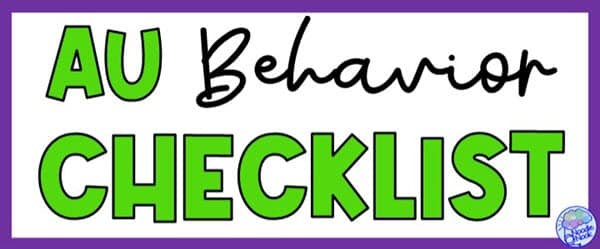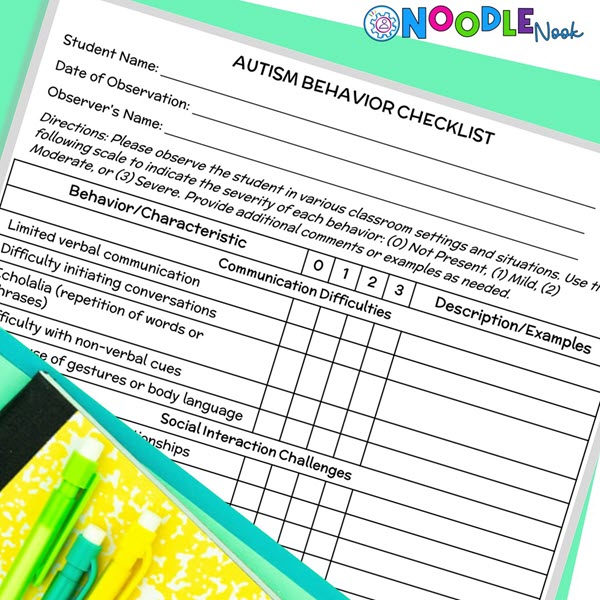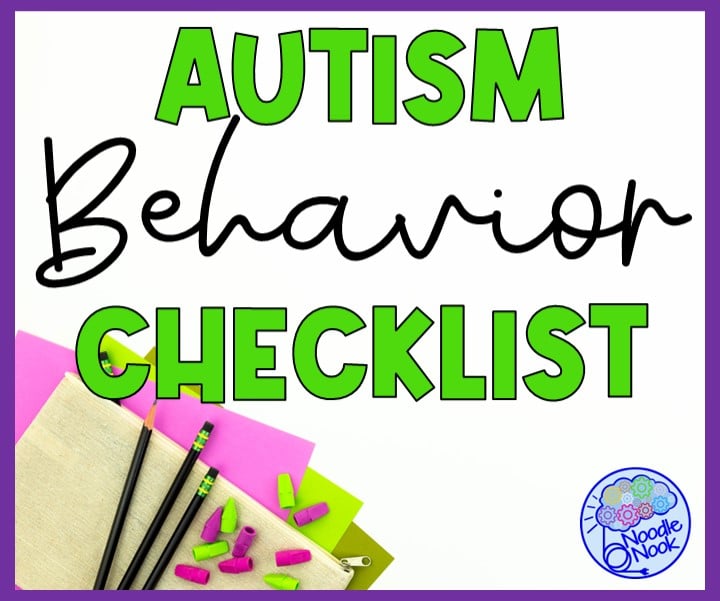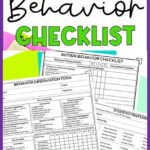It can be a very worrying experience, looking at a child and not knowing if there’s something more going on or if a child has early signs of autism. As a special education specialist, I can tell you first and foremost that a formal diagnosis is the only way to know if a child has a disability. With that said, you may be a classroom teacher wondering if you should make a referral and need a modified checklist to help guide the way. With that in mind, here are some critical things you need about autism behavior checklist implementation and use, with a few best practices and general guidelines. So let’s dive into using an autism behavior checklist.
What is an Autism Behavior Checklist?
An autism behavior checklist is a valuable screening tool to help parents, educators, and professionals better understand and support children with autism spectrum disorder (ASD). Basically, it’s a structured list of behaviors and characteristics that are commonly associated with autism. You can think of it as a handy reference guide that helps you keep track of specific traits and behaviors you may observe in someone with autism. As a teacher, this type of child behavior checklist can play a crucial role in early identification, intervention, and personalized support for a student on the autism spectrum.
How Do You Use an Autism Behavior Checklist?
Using an autism behavior checklist is pretty easy and straightforward. You’ll set up an opportunity to observe the child in various settings and situations. Then, you’ll spend time noting their behaviors and characteristics. It’s best to use a checklist that incorporates a scale to rate the severity of behaviors. Sometimes the severity of a behavior can impact interventions and supports. That means getting all of that information down in one place can be extremely helpful. As you set out to use your checklist think of it as an essential tool to providing a clear snapshot of an individual student and their behavior.
What Behaviors Should You Look For?
Most autism behavior checklists have pretty clear categories that help organize the behaviors you should be looking for. Most of the time these include things that are common in students with autism. It will likely include communication difficulties like limited verbal communication, repetitive behaviors such as hand flapping, challenges and social interactions like difficulty making peer relationships, and sensory sensitivities like over or under reacting to stimuli. Again, a good Autism behavior checklist will allow you to note the severity of each specific behavior so that you can create a more accurate profile of the student’s individual needs. By doing so, you can better tailor supports and interventions for that student.
Common Behaviors in Autism
Remember, there is no one-size-fits-all when it comes to autism spectrum disorders. That’s such an important point that the word spectrum is part of the label! Students will have behaviors, special abilities, and needs that run the gamut. With that in mind, here are some of the key behaviors associated with autism:
- Limited verbal communication or delays with speech and vocalization
- Repetitive behaviour patterns or repetitive play (like lining up toys in a row)
- Challenges in social situations and with social interaction
- Difficulties with non-verbal cues, such as body language and facial expressions
Additionally, individuals with ASD may:
- Developmental delay, or delays in cognitive development
- Exhibit intense focus on specific interests
- Struggle with changes in routines
- Have sensory sensitivities, such as being highly sensitive to loud noises or certain textures
- Challenged with self-regulation and managing emotional problems
Typically, these are some of the most pronounced behaviors associated with autism. In order to make a more informed observation, don’t just rely on this list. Refer to a long form autism behavior checklist that includes intensity to get a better idea about the likelihood of an autism diagnosis.
5 Key Things to Remember About an Autism Behavior Checklist
When it comes to using an autism behavior checklist, there are a few important things that you should know.
1. Individual Variation.
Autism is a spectrum disorder. That means that individuals with autism can and will display a wide range of behaviors and characteristics. Know this; No two individuals with autism are alike. So that means that an autism behavior checklist is not foolproof. In fact, an effective behavior checklist should be flexible and adaptable. This is to accommodate the wide variety of unique needs and behaviors you will see with people on the spectrum.
2. Early Intervention is Key.
Early identification and intervention are extremely important for students with autism. That’s why behavior checklists can be such valuable tools. Early screening and assessment can help a teacher get a referral for services as soon as possible. The earlier an intervention is provided and services are established, the better outcome a student can potentially have.
3. Comprehensive Assessment.
An autism behavior checklist is not a diagnosis tool. This might be the most important takeaway on this list. No single checklist can be comprehensive or all-encompassing. So, use a checklist as part of a more formal assessment process or to determine if further evaluation is warranted to lead to an autism diagnosis.
There is a place for a checklist like this as part of a broader tool or process for assessing with an autism screening instrument. Typically that includes gathering information from multiple sources, including parents, teachers, therapists, and physicians. This holistic approach gives a more accurate picture of the student’s strengths and challenges. A formal diagnosis process should be implemented if you are a teacher suspecting a disability.
4. Strengths-Based Approach.
While using an autism behavior checklist often focuses on identifying areas of challenge, it’s equally important to recognize strengths. Leveraging the strengths and interests of a student with autism can improve outcomes significantly. As you approach completing a checklist, pay special attention to how educators and paraprofessionals can use interventions that are tailored to the individual. The process of diagnosing and labeling a student is so that we, as teachers, can develop more effective strategies to use in the classroom.
5. Ongoing Monitoring and Adjustments.
Finally, remember that behavior checklists are not static documents. They should be used regularly as a dynamic tool for ongoing assessment. Take time throughout the school year to regularly review and update the checklist. It’s a great way to track student progress and see if they are responding to interventions.
Look for a checklist that offers flexibility and adaptability, allowing you to quickly review it and adjust your supports and strategies in the classroom.
Part of the Behavior Data Sheets Resource in the Noodle Nook store, it’ll have you on top of your data and classroom behaviors too!
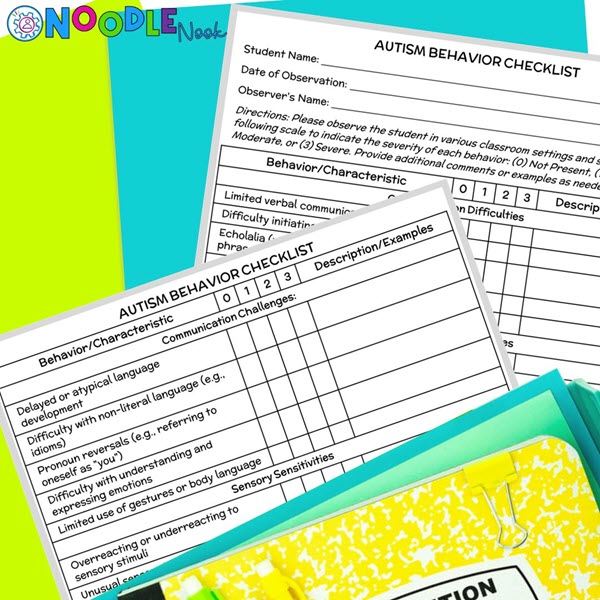
RECAP: Autism Behavior Checklist
While an autism behavior checklist is a valuable tool, it is not a formal diagnostic instrument. The checklist serves as part of a broader assessment process, involving healthcare professionals and a multidisciplinary team. Ultimately, it contributes to early intervention, improved understanding, and the development of tailored educational programs. For more specific guidance, please refer to the guidelines and resources provided by healthcare professionals and educational institutions.
FAQ for Autism Behavior Checklist
- What is an Autism Behavior Checklist used for? An autism behavior checklist is used to assess and document the behavior and characteristics of young children to aid in the diagnosis of autism spectrum disorder (ASD). It helps in educational planning and understanding a child’s development.
- How does the checklist assess social communication and interaction skills? The checklist includes items related to a child’s social communication, social interaction, body language, facial expressions, and communication skills. It can help identify common signs and symptoms of ASD in these areas.
- Are there specific age groups for which a checklist is designed? An autism behavior checklist is typically used for young children, especially those at high risk of developmental disorders. It can be applied to children ranging from months of age to around 5 years old.
- How reliable are the assessment instruments like the Autism Checklist? An autism behavior checklist is not a formal assessment. It is an informal inventory that can be used to drive decisions. For teachers, it is a way to stay objective in reviewing behavior, which offers more reliability and consistent results.
- Can healthcare professionals use this checklist for diagnosis? Healthcare professionals often use a combination of assessment tools, including an autism behavior checklist, in the diagnosis of autism. However, a qualified specialist or a diagnostic team is typically needed for a formal diagnosis.
- What are the core symptoms of autism spectrum disorder? The core symptoms of ASD include repetitive patterns of behavior, communication challenges, and difficulties in social interaction. A checklist can help identify these core symptoms.
- Are there any lesser-known signs of ASD that the checklist can detect? Yes, when a checklist uses an intensity rating, it can help identify lesser-known signs or behaviors associated with autism spectrum disorder, ensuring a more comprehensive assessment.
- Can parents use a checklist to express concerns about their child’s behavior? Yes, parents can use an autism behavior checklist to document and express concerns about their child’s behavior. It can be extremely helpful to identify characteristics of autism and share those clearly with healthcare professionals and educational teams.
- How does a checklist contribute to educational planning? A checklist (like the one in the pictures on this post) provides valuable information about a child’s behavior and development. Since there is an intensity scale, it allows you to come up with a total score as part of your data collection process. That means this point checklist can help guide the IEP team as it develops educational programs and interventions tailored to the child’s specific needs.
- What are the potential benefits of using an autism behavior checklist? – Using the checklist can lead to early intervention, a better understanding of a child’s behavior, and the provision of extra support where needed. It can also facilitate research on autism and guide educational programs.
Please note that the checklist is just one component of a systematic approach to the diagnosis and support of individuals with autism spectrum disorder. Diagnosis and assessment should involve healthcare professionals and a multidisciplinary team, and it should consider the criteria outlined in the Diagnostic and Statistical Manual of Mental Disorders (DSM-5) or other relevant guidelines.

